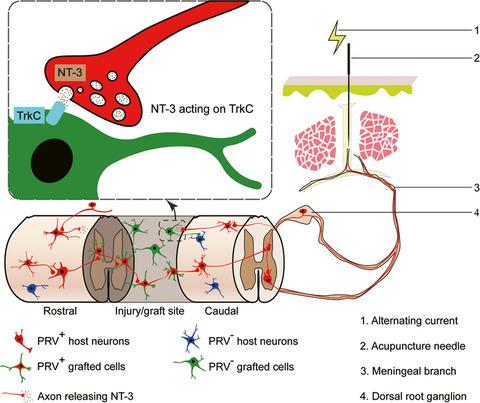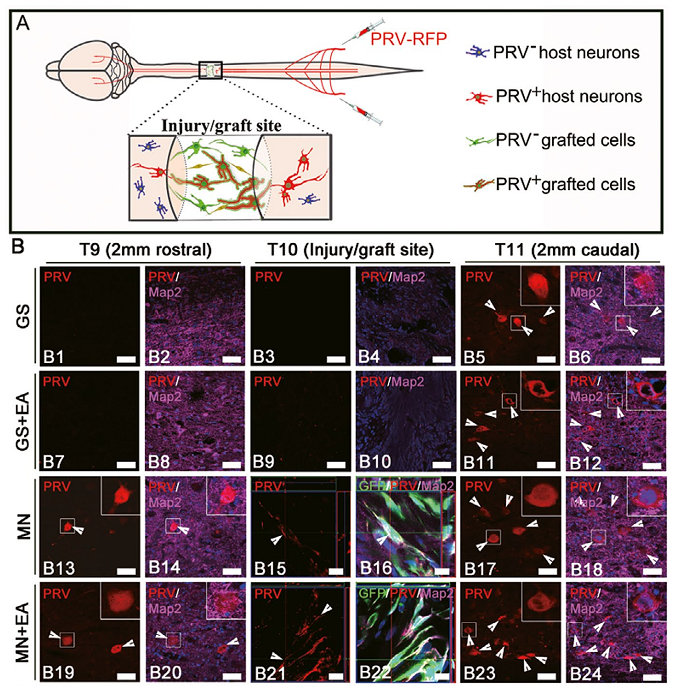Pseudorabies Virus (PRV) was used as trans-synaptic retrograde tracer. (From
BrainVTA)
The viruses used in this article from BrainVTA are in the table below
|
Pseudorabies Virus (PRV) |
PRV-RFP |
Yang Yang, Hao-Yu Xu, Qing-Wen Deng, Guo-Hui Wu, Xiang Zeng, Hui Jin, Lai-Jian Wang, Bi-Qin Lai, Ge Li, Yuan-Huan Ma, Bin Jiang, Jing-Wen Ruan, Ya-Qiong Wang, Ying Ding, Yuan-Shan Zeng
Pub Date: 2021-02-24,
DOI: 10.1111/cns.13638,
Email: [email protected]

Aims: This study was aimed to investigate whether electroacupuncture (EA) would increase the secretion of neurotrophin-3 (NT-3) from injured spinal cord tissue, and, if so, whether the increased NT-3 would promote the survival, differentiation, and migration of grafted tyrosine kinase C (TrkC)- modified mesenchymal stem cell (MSC)-derived neural network cells. We next sought to determine if the latter would integrate with the host spinal cord neural circuit to improve the neurological function of injured spinal cord.
Methods: After NT-3-modified Schwann cells (SCs) and TrkC-modified MSCs were co-cultured in a gelatin sponge scaffold for 14 days, the MSCs differentiated into neuron-like cells that formed a MSC-derived neural network (MN) implant. On this basis, we combined the MN implantation with EA in a rat model of spinal cord injury (SCI) and performed immunohistochemical staining, neural tracing, electrophysiology, and behavioral testing after 8 weeks.
Results: Electroacupuncture application enhanced the production of endogenous NT-3 in damaged spinal cord tissues. The increase in local NT-3 production promoted the survival, migration, and maintenance of the grafted MN, which expressed NT-3 high-affinity TrkC. The combination of MN implantation and EA application improved cortical motor-evoked potential relay and facilitated the locomotor performance of the paralyzed hindlimb compared with those of controls. These results suggest that the MN was better integrated into the host spinal cord neural network after EA treatment compared with control treatment.
Conclusions: Electroacupuncture as an adjuvant therapy for TrkC-modified MSC-derived MN, acted by increasing the local production of NT-3, which accelerated neural network reconstruction and restoration of spinal cord function following SCI.
 Figure 1. Pseudorabies virus (PRV) retrograde transsynaptic labeling confirmed the integration of transplanted mesenchymal stem cell (MSC)-derived neuron-like cells into the host spinal cord neuronal circuit.
Figure 1. Pseudorabies virus (PRV) retrograde transsynaptic labeling confirmed the integration of transplanted mesenchymal stem cell (MSC)-derived neuron-like cells into the host spinal cord neuronal circuit.
This study was aimed to investigate whether electroacupuncture (EA) would increase the secretion of neurotrophin-3 (NT-3) from injured spinal cord tissue. Combining immunohistochemical staining, neural tracing, electrophysiology and behavioral testing, the results demonstrate that electroacupuncture as an adjuvant therapy for TrkC-modified MSC-derived MN, acted by increasing the local production of NT-3, which accelerated neural network reconstruction and restoration of spinal cord function following SCI.
BrainVTA offers viral vector construction & virus packaging services for AAV, LV, RABV, PRV, HSV and VSV that help researchers explore questions about genes, neurons, circuitry structure, function of brain network, mechanism and treatment of diseases.
If you have any needs, just email us at
[email protected].

